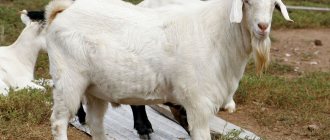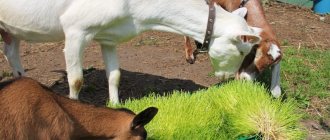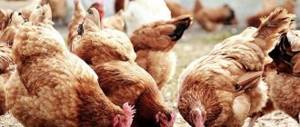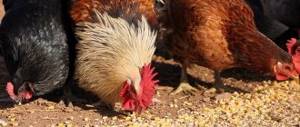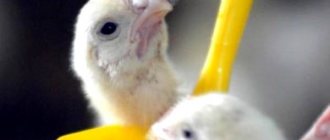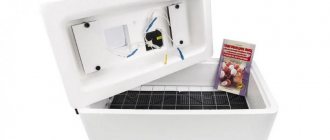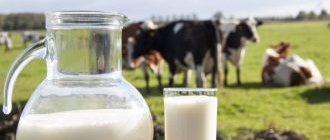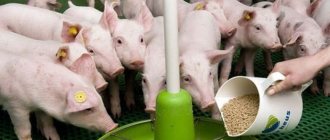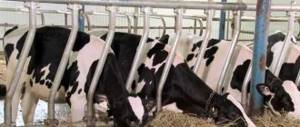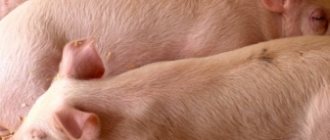Feeding cattle. General rules
Contrary to popular belief, the diet of livestock does not consist only of succulent grass. Creating a balanced “diet” for animals is not easy. Different categories of animals have different nutritional needs, so feeding bulls differs significantly from feeding heifers. Both the age and health of the animal matter.
Cattle
However, there are some general rules, for example:
- Food should be in a form convenient for consumption.
- Vitamins, minerals and other valuable substances contained in food should be easily digestible. Sometimes, to increase digestibility, special food additives are added, which are a combination of various enzymes.
- Proteins, vitamins and minerals must be in the right proportion.
- Overfeeding of animals, that is, excess nutrition, leads to disruptions in the reproductive system of cattle.
More recently, most farms considered hay to be the main food for cows. However, due to the development of the domestic feed production industry, it is gradually fading into the background. It is being replaced by balanced types of combined nutrition. Compound feed is convenient because, unlike hay, you do not need to prepare it yourself. They are also additionally enriched with vitamin supplements.
Hay for cows
Hay
Hay for cows on private farms is the main food in winter. The supply of hay and its properties determine the condition and productivity of the cow.
Hay stores all the essential nutrients: protein, fiber, minerals and vitamins. The nutritional value of hay is related to the set of plants from which it is prepared, the timing of haymaking and the factors of drying and storage. Excellent hay comes from meadow grasses, especially from floodplains, floodplains, and mountain slopes.
In accordance with the norm, the moisture content of dried hay is 14 – 17%. With such humidity, hay can be stored under a canopy or in a barn for a long period of time, maintaining its green color and delicious aroma. The green color and specific smell, as well as the presence of leaves on the plants, are signs of the significant nutritional value of hay. The leaves of cereals and legumes contain 2–2.5 times more protein and minerals and 10–12 times more carotene than the stems. The green color of hay indicates that it contains approximately the same set of amino acids as animal feed.
It has been proven that hay made from grass that is cut at the beginning of flowering has the maximum amount of nutrients. High quality hay can only be obtained through rapid drying. In sunny weather, the mown grass is first dried in swaths, then raked into windrows and turned several times or hung on a hanger, where it dries for 1-2 days.
From the windrows, hay is collected into piles weighing 200 - 300 kilograms. After 2-3 days of drying in heaps or on hangers, the hay is placed for continuous storage in a barn, under a canopy or stack, which is covered with film or roofing felt, and carefully combed from the sides so that moisture does not remain in the uneven areas during precipitation. They feed hay to cattle without any preparation. When cows are fed plenty of excellent hay, they can produce up to ten kilograms of milk per day. One kilogram of meadow hay contains 0.45 feed unit and 48 grams of digestible protein, 6.4 grams of calcium, 1.8 grams of phosphorus, 11 mg of carotene, and clover hay contains, respectively, 0.5 feed unit, 81 grams of digestible protein, 12 .9 grams of calcium, 3.4 grams of phosphorus and 25 mg of carotene.
Number of feed units per head of cattle
Lumpy dermatitis in cattle
You can find out how many feed units of feed are required per head of cattle from the table below. Based on these data, the farmer can easily independently calculate the ration for his livestock and properly organize the fattening of cattle. The table shows the diet of an adult dairy cow: the name of the feed for cattle, its quantity and the same volume, expressed in the unit of measurement “feed unit”.
Nutritional value of feed, table for cattle:
| Silage, 30 kg | 6 KU (feed units) |
| Sugar beets, 5 kg | 1.3 KE |
| Wheat bran, 600 g | 0.5 KU |
| Sunflower cake, 1.5 kg | 1.6 KE |
| Meadow hay, 6 kg | 2.6 KE |
In reality, the data may deviate slightly from the standards in one direction or another (“plus” or “minus”), this is quite acceptable. Concentrated feed for cattle is considered the most nutritious.
Roots, tubers and melons
Fodder beets, sugar and semi-sugar beets, rutabaga, turnips, carrots, potatoes, pears, pumpkin, fodder watermelon and zucchini are widely used in cow nutrition. These feeds have high dietary and milk-producing properties. They are perfectly eaten by cows, stimulate their appetite, and improve the palatability and digestibility of the entire diet. Almost all the time they are used as a supplement to the main diet when feeding dairy cows, especially during their milking in the first months after calving. Depending on the size of the milk yield, cows are fed up to 30 kilograms of fodder root crops per day, and up to 15 kilograms of sugar beets and potatoes. Root and tuber crops are fed to cattle as feed, pre-cleared of soil, in whole form or cut into large pieces.
Root and tuber crops have a high water content (70-90%), which is why they are unsatisfactorily preserved at positive temperatures, and freeze at temperatures below -2... -3°.
In particular, tubers and root crops that are damaged deteriorate very quickly. You can only keep undamaged, unfrozen, dry and cleared roots, tubers and melons in special storage facilities, trenches or piles. The temperature of the air in the storage should be within 1...2 °C. It should be dry. In order to ensure such factors, ventilation ducts for air or exhaust pipes are installed inside the pile of poles. The top and sides of the pile are covered with a 40-50 cm layer of straw and covered with 30-40 cm of soil.
For storage, melons are placed in piles in layers, sprinkled with a separate layer of straw. If root and tuber crops are frozen, they are thawed in cold water before feeding. Roots, tubers and melons can be ensiled in chopped and whole forms. When laying whole tubers and fruits for ensiling, they are sprinkled with chopped grass. Leaves of root crops and melons are ensiled in a mixture with dry feed (straw, chaff).
What can be given to cattle: proportions and recommendations
Pelleted food for rabbits
Modern veterinarians give the following recommendations regarding different types of nutrition:
- Beer grains as feed for cattle. It contains yeast, an important source of vitamin D. Beer grains for cattle can be given to animals of any age and any breed. The maximum share in the diet is 18% of the total feed.
- Compound feed for cattle. Adult cattle can be given coarsely ground feed, while young animals can be given crushed feed. The main thing is that the food is prepared in accordance with GOST. When purchasing feed for cattle, the composition is important, but manufacturing technology is no less important. The maximum share of the total nutrition is 50%.
- Meat and bone meal for cattle. Bone meal is a valuable mineral supplement. It should be given to prevent calcium deficiency. For adult cattle, the maximum share in the diet is 1.5%, for young cattle - up to 3%, since flour has a beneficial effect on bone formation.
- Pea straw for cattle contains a large amount of coarse fiber and improves intestinal function. The maximum share in the diet is no more than 15%. However, you should not give pea straw to sick and weakened animals, since this type of food is often affected by fungi and can also cause stomach upset due to the high concentration of plant protein. Also, such straw is quite difficult to digest.
Pea straw - Feed salt. Providing salt is required. Feed salt for livestock farming is perceived by livestock as a delicacy. This substance contains a large amount of sodium, which has a beneficial effect on metabolism and stimulates the intensive growth of young animals. The maximum share in the diet is 0.5%.
- Phacelia as a feed crop for livestock is of great value due to its content of essential amino acids and antioxidants. However, cows are reluctant to eat this grass, so it is recommended to mix it with other feeds to drown out the specific taste. The permissible share in the diet is no more than 10%.
- Beet pulp contains glucose and other sugars that provide energy. But an excess of beet pulp in the diet can cause diarrhea, so the share of beet pulp should be no more than 7% of the total diet. It should only be given to absolutely healthy animals.
- Granulated feed for livestock. It is definitely not worth feeding animals only this kind of food. And there is no need to ignore this type of nutrition either, because such food contains all the necessary nutrients in well-balanced proportions. For young animals you should purchase food with small granules, for adult animals - with large ones. The recommended proportion in the diet is 25%.
Pelleted feed
These recommendations should be followed by those who want to raise healthy livestock. When purchasing combined feeds, you should give preference to products from domestic manufacturers.
Protein substances (proteins)
Structure
Protein consists of a chain of amino acids. These structural elements of protein consist of the main elements C, H, O, N and most also of P and S.
Protein Objectives
An important component, primarily of muscle tissue, internal organs, skin and hair. A vital component of enzymes and hormones. The most valuable component of animal products (meat, milk, eggs and wool).
Classification
Crude protein includes all compounds that contain nitrogen, that is, pure protein and non-protein nitrogen. When analyzing feed using the Wende method, only part of the nitrogen is used to determine crude protein. Protein contains on average 16% nitrogen. Therefore, to determine the amount of crude protein in the feed, its nitrogen content is multiplied by 6.25 (100:16 = 6.25). Non-protein nitrogen compounds are found in many feeds, primarily in roughage (green feed, silage, root vegetables, etc.). Ruminants can utilize these compounds through rumen microorganisms.
Non-protein nitrogen compounds also include feed urea (urea).
Digestible crude protein is the portion of crude protein that is digested by the animal.
Example for pigs: soybean meal
Crude protein content = 451 g
Digestibility rate = 86%
451 x 0.86 = 388 g digestible crude protein
When evaluating a feed, it is important to pay attention to both its crude protein content and its quality (essential amino acid content).
Protein value
About 20 different amino acids take part in the formation of animal protein. Some of these amino acids must be supplied with food. They are called irreplaceable (necessary for life). The rest of the amino acids are synthesized directly in the animal's body.
It is the content of essential amino acids in the feed that determines its biological value.
Thanks to the combination of various feed components, the optimal ratio of amino acids necessary for a particular animal species is achieved.
Introduction of synthetic amino acids
The lack of essential amino acids can be compensated for by introducing synthetically produced amino acids into the feed (for example, lysine, methionine, tryptophan). It must be remembered that prolonged excess protein consumption burdens metabolism.
Special properties
Only a plant can form protein from non-protein compounds.
In feeding, protein cannot be replaced by any other nutrient. The animal does not have the ability to accumulate protein, so it needs constant replenishment of protein with food.
Origin
Protein-rich foods are: whole milk and skim milk, fish meal, broad beans, peas, feed yeast, oilseed meal (rapeseed, sunflower, soybean, flaxseed); green fodder from legumes, their silage and hay.
The main nutrients of food are water, carbohydrates, fats and proteins. In total, more than 50 different nutrients are known today. These are the building blocks using which the animal organism builds itself and replenishes its reserves. The content of various nutrients varies greatly from plant to plant. But in general, carbohydrates predominate in the composition of plants. They are the main nutrient for animals.
Bibliography:
Prof. Manfred Kirchgesner. Animal feeding: a textbook for study, consultation and practice. Prof. Manfred Kirchgesner, 11th revised edition, DLG Publishing House, Frankfurt am Main, 2004,
H. Jeroch, G. Flachowski and F. Weisbach. The doctrine of feed. Gustov Fischer Publishing House, Stuttgart. 1993
My lecture notes from FH Weihstephan, Germany
Articles on the website of the scientific center of the Bavarian Agricultural Administration, Germany
————————————-
Did you find this article useful? Forward the link to your colleagues!
I look forward to your feedback and comments. Thank you very much!
Facebook In Contact LinkedIn Email
Feeding diet for dairy cattle
Purina feed for broilers
When keeping dairy cattle, the farmer’s main task is to increase milk yield so that it does not become an unbearable burden for the animals. If we take as a basis such an indicator as the average daily weight gain of cattle, its rate will be different for beef and dairy cows. Dairy cows are not required to gain weight as quickly as breeds bred for meat. Therefore, the first place should not be gaining body weight, but increasing the amount of milk.
When preparing a diet for dairy cattle, you need to keep the following in mind:
- Different breeds of dairy cattle will have different menus.
- Vegetables, root vegetables and fresh grass should occupy an important place in the diet. These products help increase milk yield.
- Every day a dairy cow should consume up to 40 liters of fluid.
- Nutrition for dairy cattle involves feeding three times a day with a clearly fixed time for each meal.
- In summer, the share of grass in the diet increases, the share of vegetables and root vegetables decreases.
- In winter, the amount of combined feed increases.
Combined feed for livestock
In order for food to be better absorbed, they first give forage, then juicy vegetables and root vegetables, and lastly roughage (straw, hay).
Feed Nutrition Units
There are different methods for assessing the nutritional value of feed, which are characterized by certain units of measurement. They consist of accounting:
- amount of incoming nutrients;
- their excretion from the body.
The unit of nutrition is considered to be the fat formation of a pure substance. For Kellner it is starch, and for Bogdanov it is oats.
Kellner's starch equivalents demonstrate net energy expressed in energy feed units (EFU). Fat deposition coefficients have been developed for nutrients: digestible protein, starch, fiber, roughage fat, oilseed fat, grain fat. The amount of energy feed unit is 2.5 kcal net energy.
The oat feed unit (OFU) is based on Kellner starch equivalents. OKE unit – nutritional value of 1 kg of oats.
The amount of digestible nutrients consists of the amount of digestible protein, fat, extractive nitrogen-free substances, and fiber. This energy assessment of feed is practiced in the USA.
Tricalcium phosphate for cattle: instructions for use
Tricalcium phosphate is a valuable mineral supplement to the daily diet of animals. You can buy it at veterinary pharmacies. The drug comes with detailed instructions for use. If you systematically do not comply with the dosage or accidentally exceed the maximum permissible dose, instead of benefit, you can only cause harm to the animal.
Tricalcium phosphate should be used as follows:
- This supplement should be given in the spring, when the risk of vitamin deficiency is greatest.
- Giving the supplement once will do nothing. It is necessary to give tricalcium phosphate in a course lasting 1.5-2 months.
- One head needs 80-100 g of the substance per day.
- The powder dissolves in water and is given to animals in liquid form.
Experts claim that this complex mineral supplement activates reproductive instincts, stimulates lactation in dairy cows, reduces the incidence of viral and bacterial infections, and reduces the likelihood of giving birth to calves with congenital malformations incompatible with life. Also, regular inclusion of this substance in the diet helps improve metabolism, has a positive effect on digestion, and helps young animals grow quickly and gain body weight.
Tricalcium phosphate
For dairy cows, tricalcium phosphate is more important than for beef cows, since during intensive lactation a large amount of calcium is washed out of the animal's body.
For dairy cows, depending on their productivity, the rate of digestible protein per feed. units is 95... 110 g, for pregnant cows - 110, replacement young cattle
to
O
| 1. Chemical composition and energy value of basic feed (content per 1 kg) | |||||||||||
| Feed units | Exchange energy, J | Dry matter, g | Crude protein, g | Crude fiber, g | |||||||
| Feed | for cattle | for pigs | Crude fat, g | BEV, g | Calcium, g | Phosphorus, g | Potassium | ||||
| Grass: | |||||||||||
| water meadow | 0, 24 | 2, 92 | — | 311 | 39 | 10 | 86 | 150 | 2, 8 | 1, 3 | 4, 1 |
| alfalfa | 0, 22 | 1, 75 | 1, 99 | 250 | 50 | 7 | 68 | 100 | 4, 5 | 0, 7 | 5, 3 |
| red clover | 0, 2 | 1, 87 | 2, 13 | 235 | 39 | 8 | 61 | 108 | 3, 7 | 0, 6 | 2, 1 |
| Hay: cereal and forb | 0, 46 | 6, 3 | 830 | 84 | 26 | 234 | 411 | 6, 9 | 1, 7 | 7, 8 | |
| clover | 0, 52 | 7, 23 | 6, 94 | 830 | 127 | 25 | 244 | 367 | 9, 2 | 2, 2 | 7, 8 |
| clover-temo-fairy | 0, 47 | 6, 76 | 6, 67 | 830 | 98 | 25 | 265 | 388 | 7, 6 | 2, 5 | 14 |
| Herbal meal: | |||||||||||
| clover | 0, 71 | 8, 41 | 7, 98 | 900 | 171 | 31 | 207 | 392 | 14 | 2, 9 | 29, 2 |
| alfalfa | 0, 72 | 8, 62 | 7, 73 | 900 | 189 | 29 | 211 | 362 | 17, 3 | 3 | 19, 6 |
| Oat grain | 1 | 9, 2 | 10, 78 | 850 | i08 | 40 | 97 | 573 | 1, 5 | 3, 4 | 5, 4 |
| Pea grain | 1, 18 | N, 1 | 13, 06 | 850 | 218 | 19 | 54 | 532 | 2 | 4, 3 | 10, 7 |
| Clover haylage | 0, 34 | 3, 84 | 4, 44 | 450 | 53 | 12 | 143 | 207 | 5, 5 | 0, 6 | 7, 9 |
| Alfalfa haylage | 0, 35 | 4, 19 | 4, 24 | 450 | 103 | 17 | 127 | 148 | 10, 9 | 1 | 11, 9 |
| Vetch-oat haylage | 0, 32 | 3, 6 | 4, 56 | 450 | 54 | 13 | 148 | 192 | 2, 8 | 1, 4 | 9, 6 |
| Corn silage | 0, 2 | 2, 3 | 2, 60 | 250 | 25 | 10 | 75 | 119 | 1, 4 | • 0, 4 | 2, 9 |
| Cow's milk | 0, 3 | 2, 28 | 2, 88 | 130 | 35 | 37 | — | 50 | 1, 3 | 1, 2 | 1, 4 |
dairy cattle - 108... 130, young cattle when raised for meat - 80... 100 g.
Sugar protein ratio indicator
taken into account when feeding animals. In the diets of ruminant animals, for every 100 g of digestible protein there should be 80... 100 g of sugars.
To convert the nutritional value of natural moisture feed (NKNV) into the nutritional value of dry matter (DMS), use the formula
PKsv = Yu0PKnv/SV,
where DM is the mass fraction of dry matter, %.
To convert the nutritional value of the dry matter of the feed into the nutritional value of the feed with natural moisture, use the formula
PKNV = PKsvSV/100.
To a certain extent, the nutritional value of feed can be judged by how willingly animals eat it. The share of the consumed part of the feed in the total mass of feed provided to the animals is called the eatability coefficient
and is usually expressed as a percentage. The coefficient of consumability, or completeness of use, is used to characterize the degree of grazing of pasture grass.
In pasture grass, animals can eat some herbs to varying degrees and leave others uncut. In this case, we can talk about excellent, good, satisfactory and poor edibility of herbs, as well as their inedibility.
Many factors influence the palatability of feed. These include genetically fixed feeding habits of certain species and individuals of animals, the presence of smell, taste in feed, morphological characteristics of plants (presence of awns, abscesses), the physical state of feed (degree of grinding, hardness), its contamination.
Poor feed palatability can cause lower dry matter intake and, as a result, reduced animal productivity.
1. 3. SUBSTANCES THAT DECREASE THE NUTRITIONAL VALUE OF PLANT FOOD AND HAVE A NEGATIVE INFLUENCE ON ANIMAL HEALTH
Substances that, when introduced into the body of animals in certain quantities, can cause disruption of physiological functions, poisoning and even death, can be divided into two groups.
The first group includes substances that accumulate in plants as metabolic products, that is, they are natural components of their chemical composition. They accumulate in the highest concentrations in wild poisonous and medicinal plants.
Tips and tricks from experienced livestock breeders and veterinarians
So that a novice farmer can easily organize feeding of his livestock, it is recommended to follow the recommendations of experienced livestock breeders and practicing veterinarians. Here's what they advise:
- When making hay yourself, you need to make sure that no poisonous plants get into it. Also, you should not graze your herd in areas where these crops grow.
- If animals eat a lot of pelleted food, they may be constantly thirsty, so make sure they have enough fluids.
- Dairy cows need to be watered more actively than beef cows, as they spend more fluid.
- In addition to meat and bone meal, powdered eggshells can be added to animal food as a valuable source of calcium.
- If the cattle are not gaining weight well, you should not immediately increase the single portion of feed. First you need to consult a specialist. If the cows are sick, increasing the usual portion will only do harm. First you need to find out the reason for poor weight gain and only then take action.
Important! When animals are given pieces of lick salt, they must be large enough so that the cow cannot choke or accidentally swallow a piece.
It should be borne in mind that in the summer, when most of the diet consists of fresh, succulent food (grass, vegetables, root vegetables), fermentation processes in the stomach may become more active in animals. In this case, the proportion of dry feed should be increased. Food supplements containing digestive enzymes, which make food easier to digest, will also help solve the problem.
If you properly organize the nutrition of animals, the livestock will grow and develop safely. Feed intended for livestock must be of the required quantity and quality. The individual needs of different categories of animals should also be taken into account. And then the farmer’s milk yield will increase or after slaughter there will be a large yield of meat.
0 0 votes
Article rating
Chemical composition of feed
Water content in feed
Water is not a nutrient. Serves as a medium in which metabolic processes occur.
The water content in feed varies within fairly significant limits. Dry food contains water from 6-8 to 18-20%. At this humidity, the feed is not damaged by mold and can be stored for a long time. In succulent feeds, the moisture content ranges from 50-90%. Humidity affects the nutrient content of feed. However, succulent feeds, as a rule, are eaten quite readily, and their dry matter has a high nutritional value, usually the same as that of average concentrates.
Macroelements in feed
Ash - the ash content in the dry matter of feed is 2-10%, although some feeds, such as meat and bone meal and fish meal, may be higher. Ash contains a set of oxides and salts of macro and micromineral elements.
Calcium and phosphorus - the content of these minerals in the body of animals is 2% of weight, and their specific gravity among mineral compounds is 65-70%. Basically, calcium and phosphorus are part of the bone tissue of animals; usually calcium and phosphorus are found in bone tissue in the form of tricalcium salt of phosphoric acid.
With a lack of calcium in feed, a disturbance occurs in the formation of bone tissue, which becomes soft, fragile, and contains excess cartilage tissue; After cooking the bones, the bone sutures appear enlarged. In young animals with a lack of calcium, a severe disease, rickets, occurs; in this case, not only the formation of the skeleton is delayed, but also growth is inhibited, metabolism is disrupted, and feed absorption deteriorates. Animals that have had rickets are not able to use feed well, grow slowly, and have low productivity.
Calcium is of great importance in the functioning of the nervous system. With its deficiency, disorders of the nervous system, convulsions, and tilting of the head are observed. The absorption of calcium is promoted by vitamin D. The largest amount of calcium, and at the same time phosphorus, is found in animal feed (meat and bone meal and fish meal).
Phosphorus is more widely involved in metabolism compared to calcium. With the participation of organophosphorus compounds, muscle function, protein synthesis, and digestive organs function (with a lack of phosphorus in feed, the appetite of animals is significantly reduced). Phosphorus is necessary for the formation of sperm and eggs. Thus, the role of phosphorus in metabolism is more multifaceted.
Sodium and chlorine are necessary for animals, as they contribute to the digestion of feed, being released in certain compounds in digestive juices: chlorine, for example, is released in the form of hydrochloric acid in the stomach, sodium is part of the so-called blood buffer substances, which, with increasing acidity, , as well as the alkalinity of the blood lead its reaction to the desired, slightly alkaline. This increases the endurance of animals, their ability to achieve higher productivity and greater stress.
Potassium is part of the blood and tissues.
Magnesium is essential for animals; if it is deficient, the activity of the nervous system is disrupted, convulsions and nervous disorders appear.
Sulfur is also included in the chemical composition of feed as it is part of proteins and some amino acids (methionine, cystine). As a rule, there is enough sulfur in feed.
Feeding inorganic sulfur gives a positive effect only when it is at a minimum during the synthesis of methionine and cystine in the gastrointestinal tract.
Microelements in feed
Microelements - play the role of biocatalysts, being part of individual vitamins (cobalt in vitamin B12); hormones (iodine in the thyroid hormone thyroxine). Therefore, despite the minimal need for microelements, they can play a significant role in metabolism.
Lack of microelements causes a number of diseases, reduces productivity and impairs feed utilization. The lack of minerals in feed is compensated for by mineral supplements. Of course, feeding micronutrient salts as supplements has an effect when they are not enough in the diet.
Iron - Animals require several hundred milligrams of iron per kilogram of dry matter, more than other trace elements. Iron is usually sufficient in feed.
Copper is one of the deficient microelements. It plays a role in oxidative processes, in the process of hematopoiesis. Lack of copper in the diet causes rear paralysis, falling sickness, and diarrhea in animals.
Diseases due to copper deficiency are exacerbated by the presence of microelements such as molybdenum, lead and zinc in feed. Soluble copper salts are better absorbed by animals: sulfate and others.
Cobalt is also included in the chemical composition of feed as it is necessary for the processes of oxidation, hematopoiesis, synthesis of vitamin B12 and the formation of hemoglobin in the body.
A lack of cobalt in the diet reduces the productivity of animals, and its severe shortage causes diseases. Acobaltosis - painful phenomena caused by a lack of cobalt, usually occurs when the cobalt content in feed is approximately 0.1 mg per 1 kg of dry matter of feed and below. The lack of other microelements - manganese, zinc increases the need for cobalt.
A dose of 0.5 g of cobalt per 1 kg of dry matter of feed is toxic.
Iodine is necessary for the normal functioning of the thyroid gland. Increased doses of iodine speed up metabolic processes. With a lack of iodine, animal productivity decreases.
Zinc is part of oxidases; increased amounts are found in the brain and genitals. Zinc is a calcium antagonist.
Manganese - participates in the oxidative processes of the body.
Manganese is toxic at a dose of 4-8 g per 1 kg of feed.
Nitrogenous organic substances
Crude protein is determined by the nitrogen it contains. On average, nitrogen is considered to make up 16% of crude protein. In reality, the nitrogen content in various organic nitrogenous substances ranges from 15 to 18%.
Animals are able to use only certain nitrogenous organic compounds for nitrogen nutrition - proteins and their breakdown products (peptones, peptides and amino acids). Nitrogenous organic substances are absorbed in the gastrointestinal tract of animals in the form of amino acids. The body builds its own proteins from amino acids.
Protein is capable of being reserved in the cells and intercellular spaces of the animal body.
When there is a lack of nitrogenous organic substances in feed, animals use these reserves, secreting reserve body protein into the digestive tract, where it is digested together with feed protein. But this is unprofitable, since the already synthesized and deposited body protein, when digested, loses part of its nutritional value.
